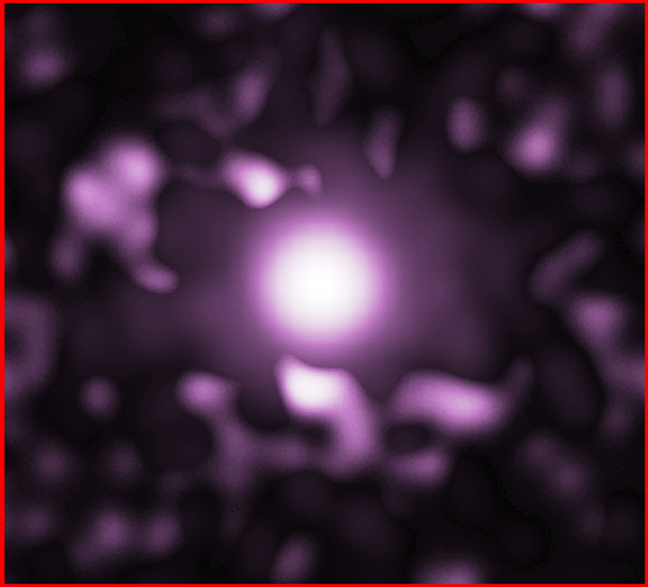
home •
about •
essential guide •
picture of the day •
thunderblogs •
news •
multimedia •
predictions •
products •
get involved •
contact
picture of the day archive subject index
X-ray features around Quasar 4C37.43 reveal its high energy transaction with its surroundings.
Credit: NASA/CXC/Univ. of Hawaii/A.Stockton et al.
May 03, 2007
Knowing Too Many Wrong Things
Once again a quasar exposes the limitations of archaic astronomy. Events around Quasar 4C37.43 point to electric currents in plasma, the one thing that is excluded in standard approaches to astrophysics.
Astronomer Halton Arp has said that it's often better not to know one wrong thing than to know many things that are right. An untested assumption masquerading as a known fact will predispose a scientist to dismiss all contrary evidence or to hide it behind a muddle of conjectures. An example is this caption to the image of x-ray activity around a quasar:
"Clouds of hot, X-ray producing gas detected by Chandra around the quasars 4C37.43 [shown above] and 3C249.1, provide strong evidence for galactic superwinds, where a quasar in the center of a galaxy has turned on and is expelling gas at high speeds. The X-ray features seen at five, six, ten and eleven o'clock … in the 4C37.43 image are located tens of thousands of light years from the central supermassive black hole that powers the quasar. They are likely due to shock waves in the superwind".
The press release explains further:
"Mergers of galaxies are a possible cause for the ignition, or turn-on, of quasars. Computer simulations show that a galactic merger drives gas toward the central region where it triggers a burst of star formation and provides fuel for the growth of a central black hole.
"The inflow of gas into the black hole releases tremendous energy, and a quasar is born. The power output of the quasar dwarfs that of the surrounding galaxy and pushes gas out of the galaxy in a galactic superwind".
The caption underscores a series of misconceptions, including the following ideas that do not deserve to be promoted as secure knowledge:
• the idea that plasma is a hot gas and can be described by gas laws, with minor modifications for magnetic effects;
• the idea that gas can be heated until it gives off x-rays without having any electrical effects;
• the idea that a wind of charged particles — even when super-sized — is not an electric current;
• the idea that the only way to accelerate charged particles is with mechanical shock waves (and hence double layers don't exist, at least not beyond the travels of spacecraft, which have detected double layers);
• the idea that densification of matter into stars can only be accomplished with gravitational disturbances, such as mergers and collisions;
• the idea that spherical shock waves in homogeneous gas clouds can nevertheless produce regular spots and filaments of x-ray emission;
• the idea that black holes are physical entities, not reified extrapolations of mathematical speculations;
• the idea that charge separation in space is impossible and electricity, even if present, doesn't do anything.
As illustrated by the creative caption given to the Chandra image above, the information given in the release of "extraordinary" discoveries often belongs more to public relations than to science. It is designed to protect assumptions that are older than the space-age. When seen from another vantage point, the new evidence contradicts the earlier assumptions and accents the role of electricity in space. To determine that this is so, the independent investigator need only refer to decades of research on plasma discharge. Rooted in laboratory experiments and the most sophisticated computer simulations, research into the behavior of electrified plasma now explains the very things that have confounded astronomers and astrophysicists:
• lightning-like bursts of high-energy radiation;
• x-ray sources, often paired across active galaxies along their spin axes, whose redshifts decrease stepwise with distance away from the galaxy (the pairs in the above image at five and ten o'clock and at six and eleven o'clock should be investigated further in this regard);
• "disturbed" and "peculiar" dwarf galaxies and low-luminosity spirals, also often paired across active galaxies and with larger dispersion from spin axes than the x-ray sources, whose redshifts continue the stepwise decrease but with distance toward the galaxy;
• all this activity is often embedded in and interacting with cells and filaments of radio- and x-ray-emitting plasma;
• the emissions are almost exclusively synchrotron radiation from fast electrons spiraling in magnetic fields, a characteristic of intergalactic Birkeland currents.
If today astrophysics is to address the dramatic discoveries of recent years, there must be an eagerness to question assumptions and examine alternatives. The unlearning of things previously "known" may, in fact, prove to be the greatest challenge to the space sciences in our time. But without this openness, the tendency to protect one's specialized domain can only lead to more science by new release, as astrophysicists continue to elaborate outdated assumptions.
The visionary astronomer, Halton Arp, expressed the point eloquently: "After all, to get the whole universe totally wrong in the face of clear evidence for over 75 years merits monumental embarrassment and should induce a modicum of humility." (Halton Arp, "What has Science Come To?" Journal of Scientific Exploration.)
![]()
home •
thunderblogs •
forum •
picture of the day •
resources •
team •
updates •
contact us
EXECUTIVE EDITORS:
David Talbott, Wallace Thornhill
MANAGING EDITORS:
Steve Smith, Mel Acheson
CONTRIBUTING EDITORS: Michael Armstrong, Dwardu Cardona,
Ev Cochrane,
C.J. Ransom, Don Scott, Rens van der Sluijs, Ian Tresman
WEBMASTER: Brian Talbott
Copyright 2007: thunderbolts.info
